- Home property damages could cost $109 billion by 2050, scientists estimate
- Miami faces unique risks: $31 billion in damage and 122,000 lives in jeopardy
- ‘Calculated exposure does not account for the value of critical infrastructure’
- READ MORE: NASA reveal NYC ‘hotspots’ sinking TWICE as fast as the metro area
Scientists warn dozens of coastal cities are in danger of being washed over by flooding due to rising sea levels – but two dozen are at higher risks.
A team of researchers led by Virginia Tech identified 24 locations that are battling a combination of sinking land and rising sea levels, putting one out of every 50 resident at risk.
Those living along the Gulf of Mexico and the Atlantic seaboard were deemed in the ‘danger zone,’ while Pacific coast residents faced less flood risk and ‘relatively modest, rock coast cliff retreat’ – but are still not out harms way.
Miami, true to past estimates, faces some of the highest risks, the researchers said.
South Florida’s sun-drenched party city could lose as much as 81,000 homes, coming to a total cost up to $31 billion dollars and risking the lives or wellbeing of as many as 122,000 Miami-area residents: all figures the study called ‘conservative.’

Over 500,000 US citizens across 32 major cities are expected to be displaced by the flooding, due to home property damages that could cost up to $109 billion by 2050. Scientists warned that nearly one foot of rising sea-levels is likely to compound the risk of ‘destructive flooding’
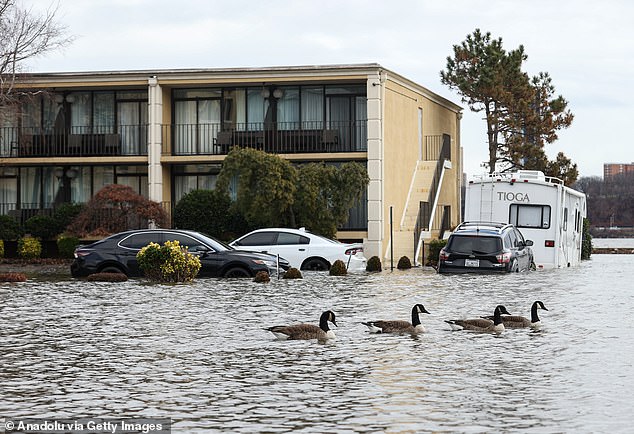
Along the Atlantic coast, the researchers calculated that as many as 263,000 people across as many as 163,000 properties were at risk of being impacted by rising sea levels across 370 square-miles of dense urban landscape. Above, a flood this January in Edgewater, New Jersey
The study identified more than 500,000 people in 32 major cities, home to that are expected to be displaced by the flooding, due to home property damages that could cost up to $109 billion by 2050.
‘One of the challenges we have with communicating the issue of sea-level rise and land subsidence [i.e. land sinking] broadly is it often seems like a long-term problem,’ said the study’s lead author, Virginia Tech geochemist Leonard Ohenhen.
‘Something whose impacts will only manifest at the end of the century, which many people may not care about.’
‘What we’ve done here is focused the picture on the short term,’ Ohenhen noted, ‘just 26 years from now.’
Three core sets of information were used to inform the new analysis, published this month in the journal Nature.
First, the scientists measured the sinking of coastal urban landmasses, to miniscule millimeter accuracy, using ‘interferometric synthetic aperture radar’ pointed at the US from aboard the Sentinel-1 A/B and ALOS-1 satellites between 2007 and 2020.
Next, they used this data to develop a ‘relative sea level rise’ adding it to the rate of true sea level rise recorded by high-resolution, ‘light detection and ranging’ (LiDAR) devices managed by the National Oceanic and Atmospheric Administration.
NOAA’s Office for Coastal Management uses their LiDAR network, a pulsed laser system that operates similarly to radar, to craft digital elevation models (DEMs) at the border between the land and the ocean.

Above, floodwaters filled with weather-beaten debris soak into a mobile home park in Fort Myers, Florida, on September 29, 2022, one day after Hurricane Ian made landfall
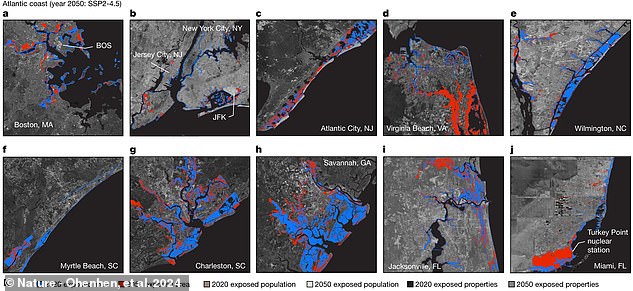
The research team, led by geochemists at Virginia Tech, calculated the Atlantic’s roughly 370 square-miles of at-risk urban landscape (in red above), as well as the at-risk Gulf and Pacific coast regions, using satellite imagery and laser-measured LiDAR
Lastly, the authors of the new study pulled in US census data from 2010 to create baseline estimates of the total likely impact of this total or ‘relative’ sea level rise on US city populations and home properties along America’s shorelines.
Along the Atlantic coast, the researchers calculated that as many as 263,000 people across as many as 163,000 properties were at risk of being impacted across 370 square-miles of dense urban landscape, mostly in Miami.
The total financial impact on home-values by 2050, the team calculated, ranged up to $64 billion total for the 11 east coast cities they examined.
Along the Gulf coast, cities like New Orleans in Louisiana, Galveston in Texas and nine more metropoles face potentially devastating risks as well.
Up to 225,000 people at risk of death, displacement or economic hardship as up to 109,000 homes face rising ocean waters, and thus closer proximity to chaotic weather patterns, like increasing hurricanes, produced by rising world temperatures.
The study estimated 319 square-miles of crowded Gulf cityscapes may be at risk.
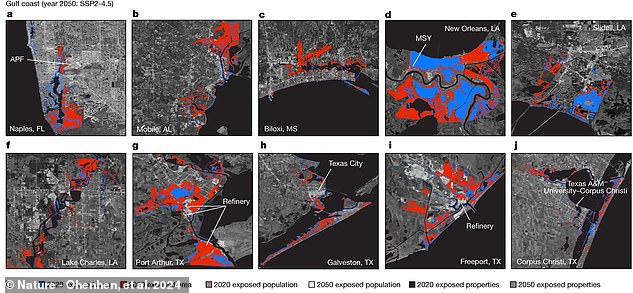
Along the Gulf coast, cities like New Orleans in Louisiana, Galveston in Texas and nine more metropoles face potentially devastating risks as well. The study estimated 319 square-miles of crowded Gulf cityscapes (marked in red above for the 2050 estimates) may be at risk
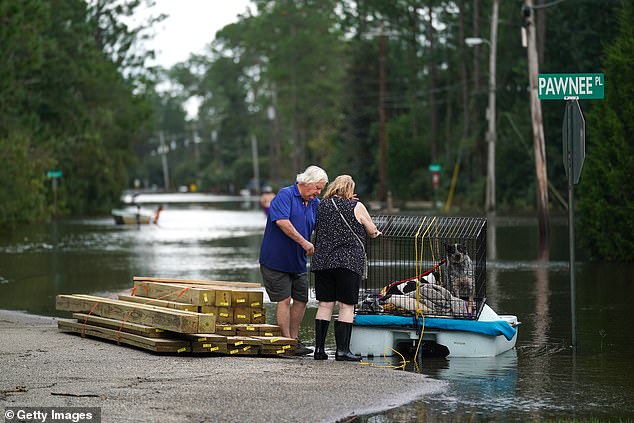
The new study estimates that up to 225,000 people risk of death, displacement or economic hardship near the Gulf (pictured) as up to 109,000 homes face rising ocean waters, and thus closer proximity to chaotic weather, like increasing hurricanes, from rising world temperatures

Despite the west coast’s reputation for environmental awareness, the ten Pacific coast cities examined by the new study faced significantly less risk than their Atlantic and Gulf analogues. By 2050, no more than 16 square-miles of Pacific homestead faced harm from rising seas
But, crucially, the team — which also included a planetary scientist from Brown University and researchers from both India and the UK — chose to focus only on damage to homes in their estimates property damage and economic risks.
‘The calculated exposure does not account for the value of critical infrastructure (such as airports, schools, hospitals, power plants, roads and railways),’ they wrote, ‘as well as economic hubs and landmarks.’
Their calculations, ranging from billions to tens of billions in local economic damage, as they put it, therefore ‘represents a conservative value.’
Ironically, despite the west coast’s vaunted reputation for environmental awareness and legislation, the ten US Pacific coast cities examined by the new study faced significantly less risks than their Atlantic and Gulf counterparts.
By 2050, no more than 16 square-miles of Pacific urban homestead faced a serious risk from rising seas and the exacerbating role of heavyweight skyscraper sinking.
Somewhere under 30,000 people and 15,000 home properties are at risk, totally no more than $22 billion in the researchers’ conservative worst case scenario.
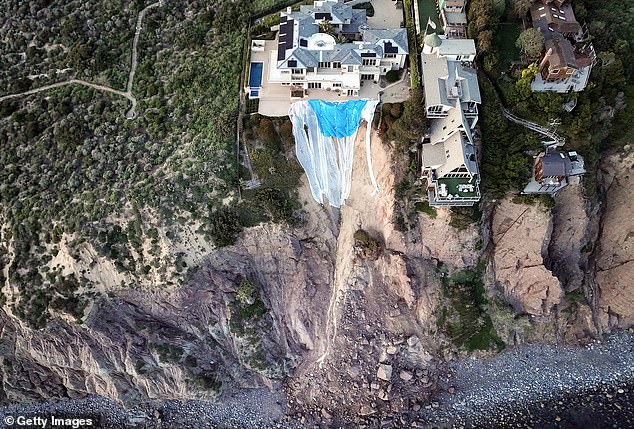
Pacific coast residents faced less flood risk but did face a unique risk of ‘relatively modest, rock coast cliff retreat,’ the new study found. Above, an aerial view of mansions still standing after a powerful storm brought flooding and mudslides to Dana Point, California this February
READ MORE: Damning report reveals how 2023 smashed records for greenhouse gas emissions, global temperatures and sea level rise – as scientists warn climate change is ‘off the charts’
Climate change ha gone ‘off the charts’ presenting a ‘defining challenge’ to humanity, a damning UN report warns. The World Meteorological Organization (WMO) says several climate records were broken and in some cases ‘smashed’ last year. Greenhouse gas levels, surface temperatures, ocean heat and acidification, sea level rises, and Antarctic ice loss all escalating in 2023 due to fossil fuel emissions. ‘Sirens are blaring across all major indicators,’ said United Nations Secretary-General António Guterres. ‘Some records aren’t just chart-topping, they’re chart-busting […] changes are speeding-up.’
Across every city in their study, Ohenhen of Virginia Tech noted that the team found economic and ethnic minorities were in the parts of town most at risk from the relative sea level rise.
‘That was the most surprising part of the study,’ Ohenhen said in a statement.
‘We found that there is racial and economic inequality in those areas in that there was an overrepresentation of historically marginalized groups potentially impacted as well as properties with significantly lower value than the rest of the cities.’
The combination of the sea-level dangers and these residents lack of economic resources to cope ‘really multiplies the potential impact to those areas and their abilities to recover from significant flooding,’ Ohenhen said.
Perhaps most alarmingly, the speed at which sea level is now rising, according to the new study, and other recent investigations, continues to climb faster.
Over the past 100 years, the average or so-called global mean rate of sea level rise hovered up to around 0.07 inches (1.7 millimeters) per year.
But by the early years of the 21st Century, that rate lept up to 0.12 inches (3.1 mm) per year and is still accelerating.
Today the global mean rate of sea level rise is 0.15 inches (3.7 mm) per year.
‘Even if climate change mitigation efforts succeed in stabilizing temperature in the future decades,’ the researchers warn in their new report, ‘sea levels will continue to rise as a result of the continuing response of oceans to past warming.’
In other words, a significant amount of their risk estimates for 2050 may be unavoidable.
Although, as study coauthor Manoochehr Shirzaei noted, their hope is to give these US coastal cities exactly the kind of map they will need to prevent the worst of the likely oncoming tragedies.
‘The whole purpose of this paper is to provide data to support decisions,’ according to Shirzaei, a geophysicist and associate professor at Virginia Tech’s Earth Observation and Innovation Lab.
‘Every city, every county has a flood resiliency plan in place. They are required by law to create that.’
‘But it’s likely nobody has received the entire picture until this study,’ he concluded, ‘which creates probably the first comprehensive picture of what’s happening in the not-too-distant future.’
Read more
News Related-
Recall Just Announced For Popular Cookies Featured In Holiday Gift Baskets
-
Eagles rally past Bills in overtime as Chiefs win
-
Reality bites the green energy agenda
-
Sandigan orders Marcos Sr. pal to pay workers
-
DSWD: Shear line, LPA affect 1.2 million people; over 18,000 families evacuated
-
The mayor of Paris is making a loud exit from X, calling the platform a 'gigantic global sewer'
-
Rain showers, thunderstorms over Luzon, including Metro Manila — Pagasa
-
'Naruto' live-action film adaptation is in the works
-
NASA Highlights Stingray Nebula
-
Manila's Lagusnilad underpass opens
-
China probes debt-ridden financial giant
-
China's VUCA situation
-
Unraveling the mystery that is diabetes
-
Bangladesh's nuke plant is not going to steal PH investments
